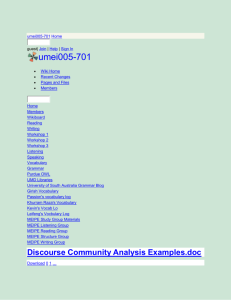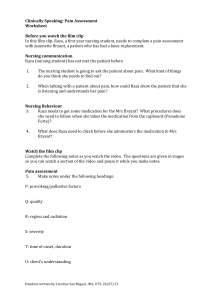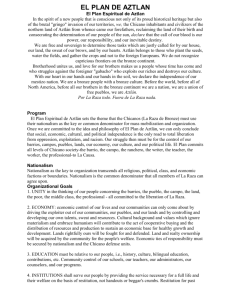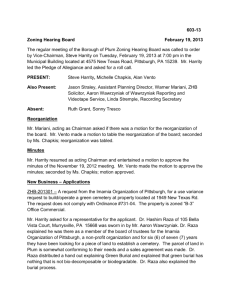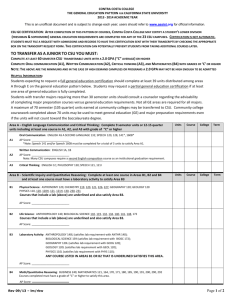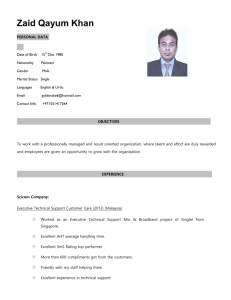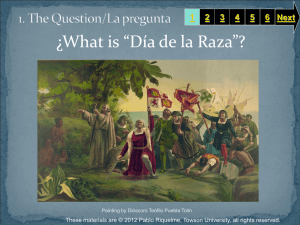Ethnic Studies: Raza Leaders & Movements Day 1: Raza History
advertisement
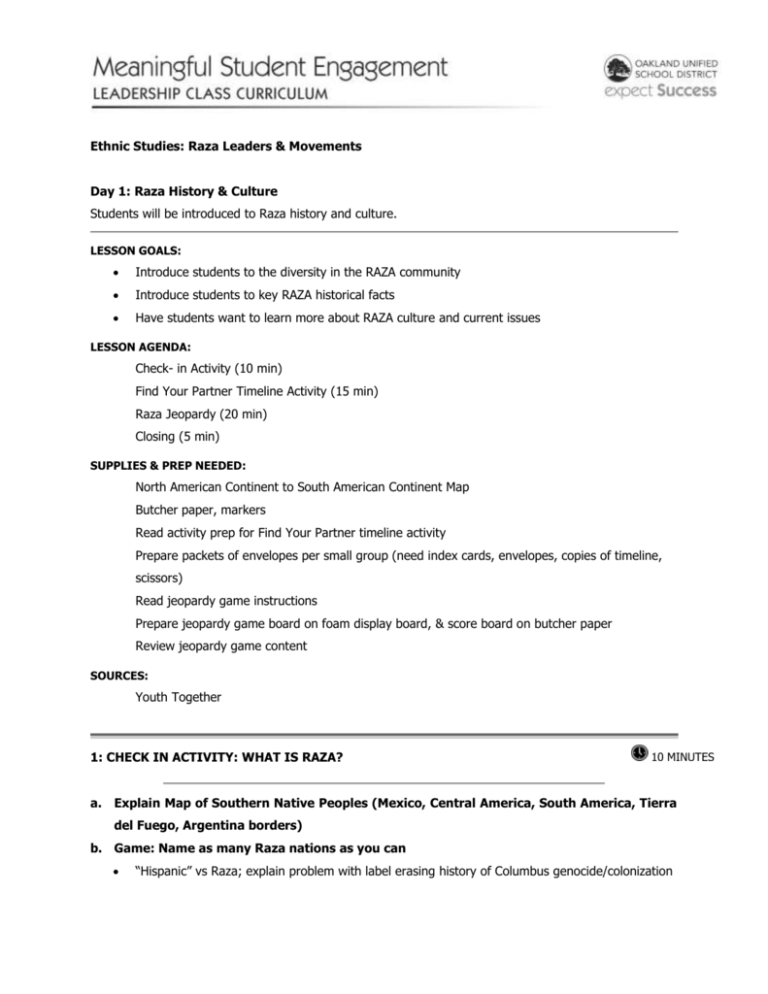
Ethnic Studies: Raza Leaders & Movements Day 1: Raza History & Culture Students will be introduced to Raza history and culture. LESSON GOALS: Introduce students to the diversity in the RAZA community Introduce students to key RAZA historical facts Have students want to learn more about RAZA culture and current issues LESSON AGENDA: Check- in Activity (10 min) Find Your Partner Timeline Activity (15 min) Raza Jeopardy (20 min) Closing (5 min) SUPPLIES & PREP NEEDED: North American Continent to South American Continent Map Butcher paper, markers Read activity prep for Find Your Partner timeline activity Prepare packets of envelopes per small group (need index cards, envelopes, copies of timeline, scissors) Read jeopardy game instructions Prepare jeopardy game board on foam display board, & score board on butcher paper Review jeopardy game content SOURCES: Youth Together 1: CHECK IN ACTIVITY: WHAT IS RAZA? 10 MINUTES a. Explain Map of Southern Native Peoples (Mexico, Central America, South America, Tierra del Fuego, Argentina borders) b. Game: Name as many Raza nations as you can “Hispanic” vs Raza; explain problem with label erasing history of Columbus genocide/colonization 2: TIMELINE ACTIVITY: FIND YOUR PARTNER 15 MINUTES This step introduces us to Raza’s historical, political, cultural and economic role in the United States and internationally. a. Activity Prep Make copies of the events and dates listened on the Find Your Partner Activity Sheet. Cut them in strips and paste them on 4x6 index cards. Place date in one envelope and events in another envelope b. Find Your Partner Ask participants to divide the class into 2 groups. One team will get the event; the other will get the dates. After the teams have been decided, each member draws an event or a date from the envelope. Tell the groups they will have 10 minutes to find their mate (the person holding the date that goes with its significance). Suggest that they look for time clues in the event. Ask each pair to line up in the correct chronological order of when the events occurred (500A.D; 1492, 1896 and so on). Signal when it’s time to start; considerable commotion and discussion will follow. At the end of 10 minutes, signal that time is up. Have pairs read off the events with the dates in the order they should appear. Recognize the team with the most dates in the right order. Then have both teams put themselves in the right order. 3: RAZA JEOPARDY 20 MINUTES The purpose of this game is to provide students with an overview of all the information they learned in the previous activity. It is opportunity for students to have fun with the new information. Ask participants to divide the class into 2 to 3 equal groups. Students should write down their name on the board/butcher paper and keep score (or assign a score keeper). Explain that the entire group will be playing a game like Jeopardy, only in teams. Remind students that you will read the answer, and they will give the question that matches the answer. Tell students you will begin by choosing the first category. They will then choose categories during the rest of the game. The student who raises a hand first gets to answer for his or her team. You may wish to modify the guidelines to solicit full team participation. If the students states the correct question, his/her team picks the next category and proceeds. If the student is incorrect, the other team gets a chance to state the question. The team with the most point wins. 5 MINUTES 4: CLOSING 1. De-Brief Was the game hard? Why don’t we know Raza history? What kind of history do we know? What are the results of not knowing Raza history? 2. Checking Out What are some questions you have always wanted to know about Raza peoples? – where/how might you find out? Ethnic studies, local events, etc… What’s one thing you learned today and how did it impact you? Find Your Partner Timeline Activity Year / Event Pre-1492 Major social and historical accomplishments by major Indigenous societies, such as the Olmecs, Mexica/Aztec, Maya and Inca. Facts that were destroyed, erased, forgotten or co-opted by European Invaders. Pre-1492 Indigenous Unity & Philosophy One Land, One People Pre-1492 Indigenous Unity and Identity 1492 – October 12 Christopher Columbus & Crew get lost and land in Western Hemisphere on the Island he named Espanola, next door to Haiti/Dominican Republic. 14xx – The Western Hemisphere is named “the Americas” after the first documented European explorer Amerigo Vergucci. 1500s – Significance Fully developed Indigenous societies whose sustainability and progress is based on the development of… (1) Agriculture: Extensive system that evolved around the harvesting of Corn, Beans, Chiles, Potatoes, Coco, Peanuts, Avocado, Rubber, etc. (2) Architecture: The pyramids throughout the “Americas” are testament to large scale construction. The architectural work included extensive systems of irrigation, canals, wells that brought clean water to homes, towns and harvest. (3) Scholarship: Education systems (universities) were implemented that focused on the areas related to social development and sciences, including writing, history, philosophy and astrology. (4) Medicine: The Inca had mastered Dentistry for health and aesthetics. While the Maya surgical procedures have been proved to have included brain surgeries and surgical amputations. Indigenous People believe that the Earth is a living entity that cannot be owned or controlled by people, and that it is people’s responsibility to take care of it. Indigenous people also believe that all humans are related because we are all need the same basic needs to survive like air, water, crops, and a healthy community. Although there have always been difference and conflict, Indigenous people of the Americas had a grounding in natural harmony that Europeans did not understand. Language, Ceremony and Earth relations continue to unite people of the Western Hemisphere. For example: (1) Nahuatl / Uto-Aztecan – is the prevalent language spoken by Native people from Canada down to Nicaragua. (2) Food – Corn, Beans, Chiles, Potatoes, and Turkey are example of foods that were eaten throughout. Some were Native to the many individual regions and others that were traded across lands. Their arrival of Europeans symbols the end of Native sovereignty and the beginning of white supremacy and exploitation. The Spanish automatically assign Native people the status of animals and claim ownership of all land, people, and resources. Slavery begins, with the Native people and later with African captives. Another example of European misinterpretation and White supremacy was the imposition of European names to Indigenous places and things. The Western Hemisphere was known by different names such as Turtle Island, Anahuak, and Abya Ayala. Legal system that established white supremacy and privilege Slave / Caste System is established by the Spanish Crown throughout the Americas. based on where you were born and who were your parents. 36 categories were created that determined people’s freedom, rights, level of segregation. It was a racist system that equated darker-skinned people with being less than human and therefore deserving of less or no rights. 1700s – Junipero Serra along with other Jesuit Priest and Monks establish the first European establishments and domination throughout the West Coast of California. 1700 – Population shift in Latino America due slavery, to segregation, and rape. 1823 – The Monroe Doctrine 1800s – The Mexican Schools 1848 – The Treaty of Guadalupe Hidalgo 1930 – Roberto Alvarez vs. Board of Trustees of Lemon Grove School It was a system that was internalized by the Raza community in which beauty, respect and wealth is based on the shade of your skin. After the establishment of the California Missions, Native communities throughout California experienced mass enslavement, forced labor and Christian indoctrination. In Mexico’s 1770 census determines that the 1st largest population is Indians / Natives, 2nd largest is Africans, followed by Mestizos (Native-European mix), and folks of European-descent US President Monroe, made a proclamation in 1823 declaring that United States as the sole “protector” (aka proprietor) of the Americas. This was in response to the failed attempt of France to colonize Mexico. These schools were created by the US government to segregate and take away the culture and language from youth of Mexican descent. Students were forced to change their names to “American” names (i.e. Juan Johnny); parents were instructed on how to cook “proper American” food instead of Mexican food. Children were instructed in basic English and labor-related instructions. Girls were taught how to cook, clean, childrearing and sowing while Boys were instructed in mechanics, farm techniques, etc. The Treaty of Guadalupe Hidalgo was signed at the end of the Mexican-American War on February 2, 1848. The Mexican government was coerced to sell half of its country, 525,000 square miles to the United States for $15 million. This land included the states of California, Nevada, Arizona, Colorado, New Mexico, Texas, and part of Utah. The Treaty claimed to recognize prior land grants in the Southwest, offered citizenship to any Mexicans residing in the area, and the right for preservation of Mexican language, culture, and customs of people remaining on the north of the US-Mexican border. As migrant farmworkers were recruited to work in San Diego county’s Lemon Grove town, racism escalated and segregation established. Mexican children were banned from attending the public school buildings with White children and instead were 1950s – The Zoot Suit Riots a.k.a. The Navy Riots 1960-1970 Chicano Power on the Rise! 1960 – The United Farm Worker, labor Union is established. 1968 – The East LA Blowouts 1970s – The Young Lords Party for Self Defense 1970 – La Raza Unida Political Party is established 1970s – 1990s forced into a building previously used as a barn were they received substandard education and resources. Concerned Mexican parents organized the “Comite de Vecinos de Lemon Grove” (The Lemon Grove Neighbors Committee) and led to a lawsuit in San Diego’s County Superior Court. The final decision was in favor of the Mexican families and in the desegregation of public schools in CA. At the height of WWII patriotism, drunk Navy servicemen cruised LA to pick-up on Raza women. This created a climate of intimidation and later of violence. The military personnel and police attacked and criminalization of Raza youth dressed in Zoot Suits. White folks joined the riots with the belief that they were serving their patriotic duty against Raza. Inspired by the Civil Rights and Black Power movement, Chicanos and Raza begin to organize for the rights and empowerment of the community. They do this through Conference, mass community actions, and militant groups such as the Brown Berets and the Black Berets in California. The efforts to organize farmworkers by Phillip Veracruz, Filipino farmworker, was later formalized by the efforts of Dolores Huerta and Cesar Chavez when they led campaigns for basic rights for farm workers, who were mostly Raza against major produce corporations. In March 1968, hundreds of East LA high school students walked out of their classes This was the first known mass action that was youth-led and focused on Educational issues in California. RAZA youth were breaking out of accepted roles and demanding for their education and future. Many taking on the label of "Chicano" or "Chicana". It included a full week of coordinated student walkouts from high Schools throughout LA county. Students were protesting the inadequate education Raza students were receiving in public schools. Such as mass disempowerment through tracking out of college and into remedial and trade classes, corporal punishment (i.e. hitting of students for discipline), and other racist policies. They wanted bilingual education, more Chicano teachers and administrators, and courses relevant to their history, not to mention improved cafeteria food. In the end, city education officials did little to meet the student demands, and some twenty years later those who participated, while showing evidence that the demonstrations had significantly impacted their own lives, were still lamenting the problems plaguing the schools of East Los Angeles. With the spirit of resistance sweeping the nation, Boricuas (aka Puerto Ricans) are inspired to address the conditions in their communities. The conversion of a Chicago street gang into a political organization known as the Young Lords, forces the issue of Puertoricans and US colonialism into the mainstream. The first and only Raza-led political party created in the United States. This was the culmination of the Chicano community organizing and mobilizing through the 60’s and 70’s. People were rising up against a system of power that kept over Civil Wars in Guatemala, Nicaragua and El Salvador. 80% of the people poor and 80% of the land & wealth in the hands of few (10-20) families. The war and mass repression forced people out of their homes and homeland. Millions left to the US, Mexico, Europe and Australia. 1990’s The rise of anti-immigrant sentiments 2004 – With the US war against Iraq, LatinAmerican countries began to resist further US intervention. 2006 – HR 4437 - The Sensenberger Bill It started in California with the passage of 1994 proposition 187 that denied basic services and rights to undocumented migrants. This led to the federal Immigration Reform and Responsibility Act of 1996 that has made it harder for people to formalize their legal status, made it easier to deport people. It has had disproportionately affected Raza and South East Asian youth who are labeled as gang-affiliated youth. Operation Gatekeeper was established with to stop illegal immigration at the border. It brought military personnel and technology to the border. It also kicked-off the building of a wall across the US-Mexico border. Folks across South America began voting-in governments that are strongly against US intervention in their countries. The Iraq war is recognized as war for oil. Venezuela, Bolivia, Uruguay, and Cuba banned U.S. and British petroleum products in protests. The 2006 federal bill that seeks to punish all people who aid, support or house undocumented immigrants. It also includes the further militarization of the border and other clauses that deny basic rights for immigrants. Raza Studies Workshop Jeopardy Questions Native World View & Culture 100 Points Two Indigenous Nations of the Americas that had large scale Architectural and Educational systems Answer: Who are the… Maya, Aztec/ Mexica, Inca 200 Points 300 Points Name three (3) food items that are native to the Americas (fruits, veggies, dishes, etc) Historical Struggles & Benchmarks The first foreign (European) establishments and settlers in the West Coast. Answer/s: The California Missions were established in the late 1700s by Jesuit Catholic priests. The system of privilege and segregation imposed by the Spanish and Roman Church. Alliances Personal Impact Current Issues This group was inspired by the militant resistance of the Black Panther Party for Self Defense. Schools created to segregate and take away the culture and language from youth of Mexican descent. The 2006 federal bill that punishes all people who aid, support or house undocumented immigrants. Answer: The Brown Berets Answer: Mexican Schools of the 1800s Answer: HR 4437 The Sensenberger Bill Double Jeopardy 2nd largest population in Mexico in 1700’s President Nixon made this word the official term for Brown and Spanish-speaking people in the U.S. Name the two (2) states where people voted to deny basic services to undocumented and migrant families. Answer: Corn, Beans, all Chiles, Potatoes, Coco, Turkey, Peanuts, Avocado, Cilantro, Mole, Salsa, tortillas, Answer: Caste System – 36 categories classified people based on their blood/racial make-up Answer: Folks of African Descent were the second largest population in Mexico, next to Indian/Native people Medical procedure developed by the Indigenous People. An official statement by a US president that declared that US was the sole “protector” (aka proprietor) of the Americas. This group evolved out of a Chicago street gang, and helped highlight the issues of the Puerto Rican community. Answer/s: The Monroe Doctrine of 1823 Answer: The Young Lords Party Answer: Brain Surgery, Dental work Answer: Hispanic – a Latin word that highlights a European/ Spanish ancestry without acknowledging peoples Native and African roots. Name the three (3) Central Americans countries whose wars caused millions of people to migrated north beginning in the 1970s. Answer: • Guatemala • El Salvador • Nicaragua Answer: California – Prop.187, 1994 Arizona – Prop.200, 2004 The first and only Raza-led political party in the United States. Answer: La Raza Unida Political Party established in 1970. 400 Points Double Jeopardy Unifying language that was spoken in the northern hemisphere (CanadaNicaragua) Answer/s: Nahuatl/ Uto-Azteca 500 Points The name/s that Native and Raza people had for the Western Hemisphere. Answer/s: Turtle Island, Anahuak, Abya Yala The first mass action that was youth-led and focused on Educational issues in California. Answer: The 1968 East LA Blowouts These seven (7) states were coerced from Mexico when the Treaty of Guadalupe Hidalgo was signed at the end of the MexicanAmerican War in 1848. Answer/s: California, Nevada, Arizona, Colorado, New Mexico, Texas, Utah This labor union was created by a Filipino organizer, Phillip Veracruz to unite and improve the working conditions of all farmworkers. Answer: The United Farm Workers (UFW) was the union where Dolores Huerta and Cesar Chavez led campaigns for basic rights for farm workers, who were mostly Raza. These two (2) groups were invaded, enslaved and colonized by the Spanish crown for over 400 years combined. Answer:: The Philippines & Raza in most of Latin America In the 1950’s the attack and criminalization of Raza youth by police, the navy and patriotic whites is known as this. Answer: The Zoot Suit Riots The Immigration Reform and Responsibility Act of 1996 has had disproportunately targeted gangaffiliated youth of these two (2) ethnic backgrounds. Answer: South East Asian & Raza (300% increase in incarceration & deportation) Double Jeopardy This 1930’s California lawsuit inspired and led to the Brown vs. Board of Education decision that desegregated all schools in the U.S. Answer: Alvarez vs. Board of Trustees of Lemon Grove School Name two (2) countries that have banned U.S. and British petroleum products. Answer: • Venezuela • Bolivia • Uruguay • Cuba Ethnic Studies: Raza Leaders & Movements Day 2: Movie Participants will learn and gain knowledge on RAZA culture and history. LESSON GOALS: Introduce students to the RAZA community Introduce students to basic RAZA historical facts Have students want to learn more about RAZA history LESSON AGENDA: Check-in (5 min) Movie (60 min) Discussion Questions (10 min) Closing (5 min) SUPPLIES NEEDED: Movie: Viva La Causa! 500 Years of Chicano History Questions 1: CHECK-IN 2 MINUTES a. What is one thing you know about RAZA culture, or community? 2: MOVIE (VIVA LA CAUSA 00 YEARS OF CHICANO HISTORY) 60 MINUTES 3: DISCUSSION QUESTIONS 10 MINUTES What happened in the movie? Why is it important to know Raza History or culture? Do we learn these stories in school why or why not? How are Raza people similar to your own culture and history? 4: CHECK OUT a. What’s one thing you learned today? 10 MINUTES
